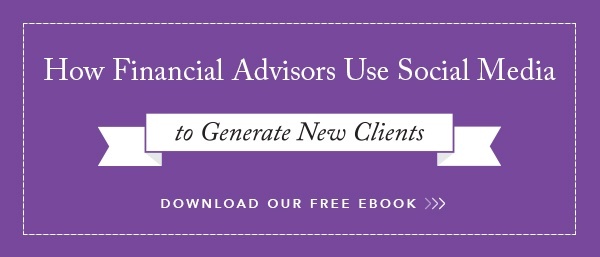

Financial Advisors: How to Create Social Media Posts That Get Noticed
Attention spans are short, and getting shorter. The average Facebook user glances at a post for an average of 2.3 seconds on a desktop computer – and 1.7 seconds on a mobile device. But it only takes a fraction of a second for the reader to burn a short post into his or her memory. So even in today’s lightning fast, digital environment, short bursts of information can still be effective, and therefore, social media for financial advisors can be extremely beneficial – that is, if your social media strategy takes this into account and gets your message across quickly enough.
Data shows that 90 percent of all high-net-worth investors are using social media now. And more importantly, your competitors certainly are. So, without a focused effort to engage your market on social media, you’re ceding a vital battleground to the competition.
Many of Paladin Digital Marketing’s clients have seen an increase in website visitors because of our social media efforts.
Here’s what you can do to compete more effectively:
1. Use more graphics and visuals.
Data from Twitter indicates that Tweets with images get 18 percent more click-throughs, 89 percent more "favorites" and 150 percent more retweets than Tweets without images.
2. Keep it simple.
No matter the platform, posts should:
- Focus on one idea per paragraph.
- Break up ideas by paragraphs, so your posts are easier to read.
- Use subheadings and bullet points.
- Eliminate jargon.
3. Don’t do it all yourself.
Financial planners aren’t copywriters or graphic artists. Any hours you personally devote to playing those roles is time better spent working with clients and meeting with prospects.
RIAs get much better results over time when they hand the ball to professional copywriters, graphic designers and digital marketing professionals. Let them run with the ball and execute your plan while you focus on serving your clients and taking introductory appointments.
4. Recycle.
If your message is worth hearing, it’s worth repeating. A lot. So, it’s OK to recycle. Go back through your old blog posts and other forms of content. Look for messages you can encapsulate and condense into a single Tweet, Facebook post or LinkedIn post. A single good blog post from years ago can be updated with new data and generate three or four quality posts. You can link back to your blog, of course, but it’s worth repeating your message and reinforcing your brand identity on your readers’ feeds even if they never click through to your blog or website.
By recycling posts, you’re still engaging, and you’re still generating “touches” that help warm up a contact and build credibility.
The Four Major Platforms for Financial Advisors
There are many social media platforms these days, but most financial advisors focus on the Big 4: Facebook, Twitter, LinkedIn and YouTube. A good social media strategy for financial advisors should include all four.
Here are tips to help get you started on each one.
- Make a business profile for your practice; not a personal one. Many planners make the mistake of using a personal profile to represent their practices on Facebook. But when you do that, you miss out on all the terrific analytic, content development, targeting and promotional tools that Facebook makes available specifically for businesses.
- Serve the reader, not yourself. We’ve all seen network marketers wear out their welcome on Facebook feeds – typically because they’re so focused on tooting their own horns that they forget they need to be posting about things that benefit their readers; not themselves.
- Subtitle your video content. As much as 85 percent of video content on Facebook is watched without sound. Burn in your subtitles and captions. LinkedIn and Facebook video files auto-play on mute as the reader scrolls down his or her feed.
- Add a “Call To Action” button. Introduced in 2014, these are customizable buttons that make it easier for you to get Facebook readers to do what you want them to do. For example:
- A button that says “reserve a seat” can allow a reader to book a seminar with one click.
- A “Make an Appointment” button can connect leads directly to your calendar.
- A “download now” button allows readers to read your eBook in seconds – and creates the possibility to add a potential lead to an automated workflow, letting you drip on a lead until they decide on a financial advisor to work with.
- A “Contact Us” button can allow a reader to immediately email you for more information.
- Be a news-breaker. Stay up-to-date on topics that are relevant to your market, and be the first to alert your Twitter followers. This could be financial planning information or news relevant to your community. Being a news-breaking account to watch is a proven way to get retweets and followers over time, increasing your reach.
- Ask for the retweet. Salesforce.com found that Tweets that included the phrase “please RT” received 12 times more retweets than posts that didn’t.
- Use hashtags. But not too many. Tweets with hashtags receive twice the engagement of tweets without hashtags. But engagement actually falls if a tweet includes more than two hashtags, according to Salesforce.
- Include images but not video. Images work well on LinkedIn – particularly when you have a great image on the top. But imbedded video doesn’t get the same play as it does on Facebook and Twitter.
- Focus on the headline. “How-to” posts and lists seem to do well on both LinkedIn and Facebook. But titles that ask a question underperform.
- Long-form content works. It pays to keep it short on Facebook. And Twitter doesn’t give you a choice. But longer word counts don’t hurt you on LinkedIn.
YouTube
- Post frequently. HubSpot data found that people are four times more likely to want to watch a video than read an article.
- Short titles work best. Research shows that posts should be 60 characters max. Be descriptive, and hit your keywords in the title.
- Rehearse. Don’t just turn the camera on and go. You aren’t that good. Even a single run-through can eliminate “umms,” “ahhs” and false starts and make your video much more watchable.
- Include a transcript and subtitles. These improve search engine results and make your video useful even for people when their speakers are down or their computers are on mute. If you aren’t sure how, your digital marketing team can do that for you.
- Ask people to subscribe and share. If you don’t ask, it won’t happen.
- Address client concerns. Don’t talk about how great your firm is. Focus on helping a viewer solve a specific problem.
- Start with a good microphone. Don’t get cheap. Nothing gets a video turned off faster than bad audio.

Debbie Freeman
Search Here
Categories
- AI (18)
- blogging (2)
- branding (1)
- content (12)
- custodians (1)
- Digital (345)
- email marketing (3)
- fcmo (2)
- fees (1)
- financial advisor marketing (62)
- Google (3)
- Ideas & Tips (78)
- Investor Experience (7)
- lead generation (7)
- linkedin (1)
- Marketing (371)
- newsletters (1)
- Online Transparency (2)
- search engine optimization (3)
- seo (9)
- Social Media (2)
- video (2)
- Websites (108)
- YouTube channel (2)
Recent Posts
-

-

How Financial Advisor Blogging Generates Thought Leadership and Leads
November 24, 2025 -

Top 5 Ways Digital Marketing Benefits Financial Advisors Seeking Leads
November 20, 2025 -

Trust Is The Biggest Online Marketing Challenge For Financial Advisors
November 17, 2025 -

Compliant Financial Advisor Bios Using AI Website Builders
October 22, 2025

